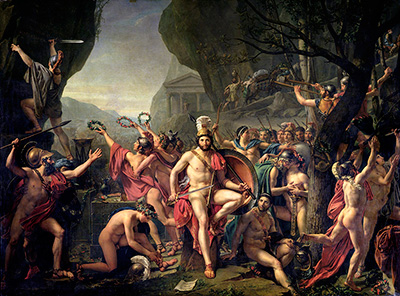Jacques-Louis David was a celebrated French painter of the 18th and 19th century. During his career, he created some well-known works. While he did paint portraits, he also painted pictures depicting historical scenes of ancient Greece and Rome. One of those pictures was the work, Leonidas at Thermopylae.
It was in 1799 that Jacques-Louis David began painting, Leonidas at Thermopylae. It took him 15 years to complete the work. The reason for this was that David stopped working on the picture in 1803. Left unfinished, it was ten years before he went back to working on the painting, completing it in 1814. The painting is an oil on canvas work that measures 13.0 ft by 17.4 ft. The picture was a complementary work for another of David's paintings, The Intervention of the Sabine Women. Louis XVIII, the King of France, purchased Leonidas at Thermopylae in 1819 for the sum of 100,000 francs. Today, the painting resides on display in the Louvre in Paris, France.
The subject of the picture is the Spartan king, Leonidas, before the Battle of Thermopylae. The centrepiece of the painting is Leonidas. In comparison to the other figures who are in motion, he appears static. For the viewer, the king is looking straight out from the picture. As he does this, he catches the viewer’s eye, drawing them into the moment of terror and pity at what lies ahead. The battle involved Leonidas and 300 volunteers, defending the pass at Thermopylae against an invading Persian army. It was a battle that led to them all being killed.
Sitting to the right of the king is his brother-in-law, Agis, waiting for his orders. Also in the picture are sentinel trumpeters sounding a call to arms. David uses them to give the viewer a sense of the action taking place. Looking behind Leonidas, there are three soldiers. They stand out in the painting because they are lifting wreaths to altars devoted to Hercules and Aphrodite. On the other side of the picture, in the top left, is a soldier on a rock. The soldier is using the pommel of his sword to carve an inscription.
Like many of his other works, David’s painting of Leonidas at Thermopylae is of the neoclassical style featuring imagery of heroism and sacrifice. It was during an exhibition of Jacques-Louis David’s latest paintings in 1799 that Napoleon Bonaparte commented on one of them. This critique led David to look again at the classical principals that inspired him. The result was him making changes to his style of painting. Painting Leonidas at Thermopylae, David's technique allows him to convey the notion of heroic courage and sacrifice.




